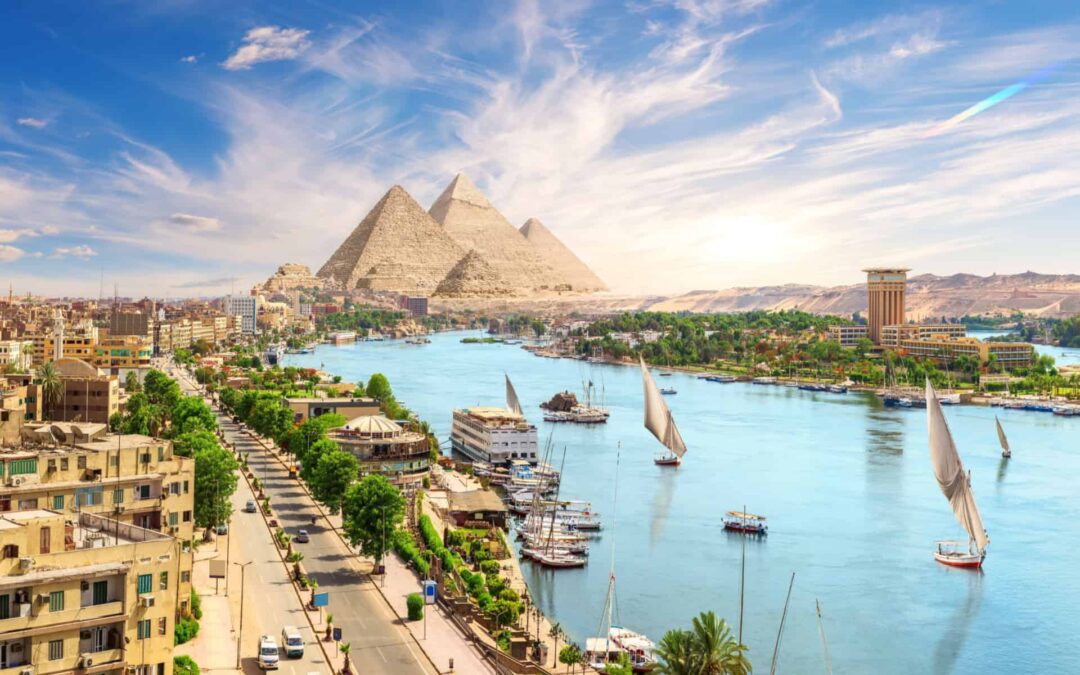The River Nile, often referred to as the “Gift of the Nile,” holds a special place in the history, culture, and geography of Egypt and the entire African continent. Stretching for over 4,000 miles, the Nile is the world’s longest river, and its significance goes far beyond its impressive length.
The Nile River is formed by two main tributaries: the White Nile, originating from Lake Victoria in East Africa, and the Blue Nile, flowing from the Ethiopian highlands. These two branches meet in Sudan, forming the Nile River proper, which flows northward through Sudan and into Egypt. The river eventually empties into the Mediterranean Sea near Alexandria. The Nile Delta, the fertile land at the river’s mouth, is often referred to as Lower Egypt, while the Nile Valley, stretching from Sudan to northern Egypt, is known as Upper Egypt.
The Nile River has played a pivotal role in the history of Egypt and the development of ancient civilisations. Key aspects of its historical importance include:
– Ancient Egypt: The Nile Valley provided a reliable source of water and fertile soil, allowing for the emergence of one of the world’s greatest civilisations. The annual flooding of the Nile, which deposited nutrient-rich silt, made agriculture thrive.
– Building the Pyramids: The construction of iconic monuments like the pyramids would have been inconceivable without the resources and agricultural support the Nile provided.
– Trade and Transportation: The Nile served as a vital trade route, connecting Upper and Lower Egypt and facilitating trade with neighbouring regions.
Today, the Nile remains crucial to the livelihoods and economies of the countries it flows through, particularly Egypt and Sudan. The river continues to play a vital role in:
– Agriculture: The Nile’s waters are used for irrigation, supporting the cultivation of crops like wheat, rice, and cotton, and ensuring food security for millions.
– Hydroelectric Power: Dams like the Aswan High Dam in Egypt and the Grand Ethiopian Renaissance Dam have harnessed the Nile’s energy for electricity generation.
– Transportation: The Nile supports transportation within and between countries along its course, easing the movement of goods and people.
The Nile holds a revered place in the cultural and religious practices of the region:
– Mythology: In ancient Egyptian mythology, the Nile was personified as the god Hapi, symbolising fertility and abundance.
– Religion: The river plays a role in various religious traditions, and its annual flooding is celebrated in festivals and rituals.
– Literature and Art: The Nile has inspired countless poets, artists, and writers throughout history, capturing the imaginations of people worldwide.
The Nile faces challenges in the form of pollution, overuse, and the impact of climate change. Dams and water-sharing agreements have also been a source of tension among the countries it traverses. Efforts to address these challenges are ongoing, as nations along the river seek to manage this invaluable resource more sustainably.
The River Nile is not merely a body of water; it is the lifeblood of Egypt and a symbol of cultural and historical significance for the entire African continent. Its enduring importance, both ancient and modern, underscores the powerful connection between natural resources and human civilisation.
As we continue to navigate the challenges of the 21st century, the Nile’s resilience and adaptability remind us of the profound impact of rivers on the course of history and the evolution of cultures.

